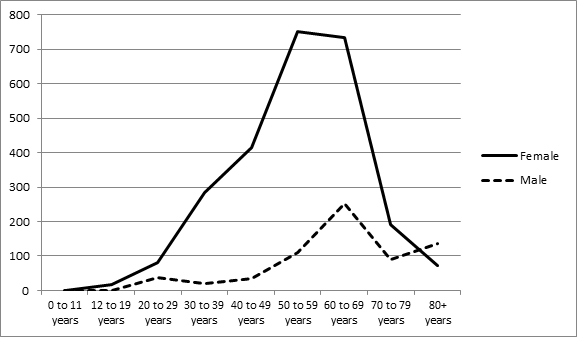Session Information
Session Type: Abstract Submissions (ACR)
Background/Purpose: Estimates of the prevalence and incidence of systemic lupus erythematosus (SLE) have varied widely but have consistently been high in women and minority populations. The goal of this registry was to determine the prevalence and incidence of SLE in the US American Indian/Alaska Native (AI/AN) population.
Methods: This population-based registry was developed as a public health surveillance project within the Indian Health Service (IHS), in partnership with the Centers for Disease Control and Prevention (CDC). The denominator was individuals: 1) included in the IHS active clinical population in 2007, 2008, and/or 2009 (2 or more visits to an IHS clinic in the past 3 years, at least one of which must be to a core medical clinic); and 2) residing in a community in one of 3 specified regions (Alaska, Phoenix, and Oklahoma City IHS Areas). Potential SLE cases were identified based on International Classification of Diseases, Ninth Revision (ICD-9) codes for SLE or related connective tissue diseases in the IHS National Data Warehouse, a central repository for clinical and administrative data. Detailed medical record abstraction was performed for each potential case. Cases were defined as individuals with documentation of 4 or more of the ACR classification criteria for SLE. Prevalence and 95% confidence intervals (CI) were calculated for 2007 overall and by region, sex, and age. Age-adjusted rates were calculated using the standard projected 2000 US population. Person-time incidence rates were calculated over the years 2007-2009 overall and by region, sex, and age.
Results: Prevalence of SLE in 2007 and incidence from 2007-2009 are presented in the Table, including unadjusted and age-adjusted rates with 95% confidence intervals (CI). Age-specific prevalence rates by sex are shown in the Figure. The prevalence was highest in women, the age group 60-69, and the Phoenix Area of IHS. The groups with the highest incidence were women, those in the age group of 40-49, and the Phoenix Area of the IHS.
Conclusion: The first population-based lupus registry in the US AI/AN population has demonstrated high prevalence and incidence of SLE in the IHS active clinical population, especially in women. Our estimates are consistent with higher rates in minority populations, and are on the higher bound of previous estimates in the AI/AN population.
|
Table: Prevalence (2007) and Incidence (2007-2009) of SLE in the IHS lupus registry |
||||
|
|
Prevalence ( per 100,000 people) |
Incidence (per 100,000 person-years) |
||
|
|
Unadjusted (95% CI) |
Age-adjusted (95% CI) |
Unadjusted (95% CI) |
Age-adjusted (95% CI) |
|
Overall |
134.5 (119.8-151.0) |
177.7 (157.1-200.2) |
5.9 (4.2-8.0) |
7.4 (5.1-10.4) |
|
Sex-specific |
|
|
|
|
|
Female |
215.4 (190.3-243.7) |
270.6 (237.5-307.0) |
8.4 (5.8-11.8) |
10.4 (6.6-14.6) |
|
Male |
35.7 (25.5-49.8) |
53.8 (36.2-77.1) |
2.7 (1.3-5.2) |
ND |
|
Region-specific |
|
|
|
|
|
Alaska |
110.2 (92.8-130.8) |
148.7 (123.8-177.3) |
4.8 (2.9-7.5) |
6.1 (3.4-10.2) |
|
Phoenix |
177.8 (149.2-211.8) |
247.5 (204.5-297.3) |
8.1 (5.0-12.6) |
10.7 (6.2-17.5) |
|
Oklahoma |
126.9 (88.9-179.1) |
138.2 (92.6-199.5) |
4.3 (1.1-11.7) |
ND |
* ND: not determined due to small number of cases.
Figure: Age-specific prevalence of SLE (2007) in the IHS lupus registry
Disclosure:
E. D. Ferucci,
None;
J. Johnston,
None;
J. Gaddy,
None;
L. Sumner,
None;
J. Posever,
None;
T. L. Choromanski,
None;
C. Gordon,
None;
S. S. Lim,
None;
C. G. Helmick,
None.
« Back to 2013 ACR/ARHP Annual Meeting
ACR Meeting Abstracts - https://acrabstracts.org/abstract/prevalence-and-incidence-of-systemic-lupus-erythematosus-in-a-population-based-registry-of-american-indian-and-alaska-native-people-in-the-united-states-2007-2009/

